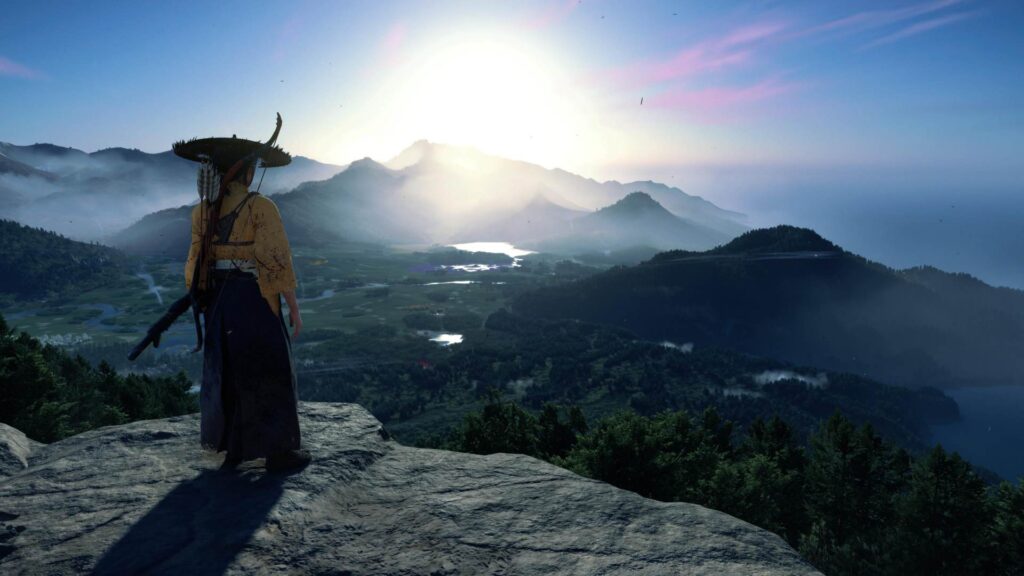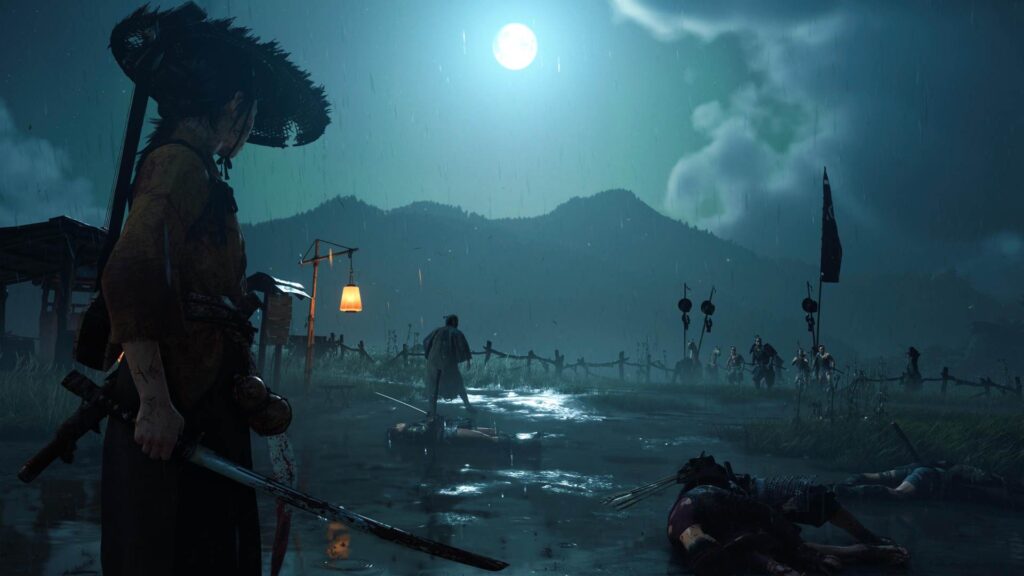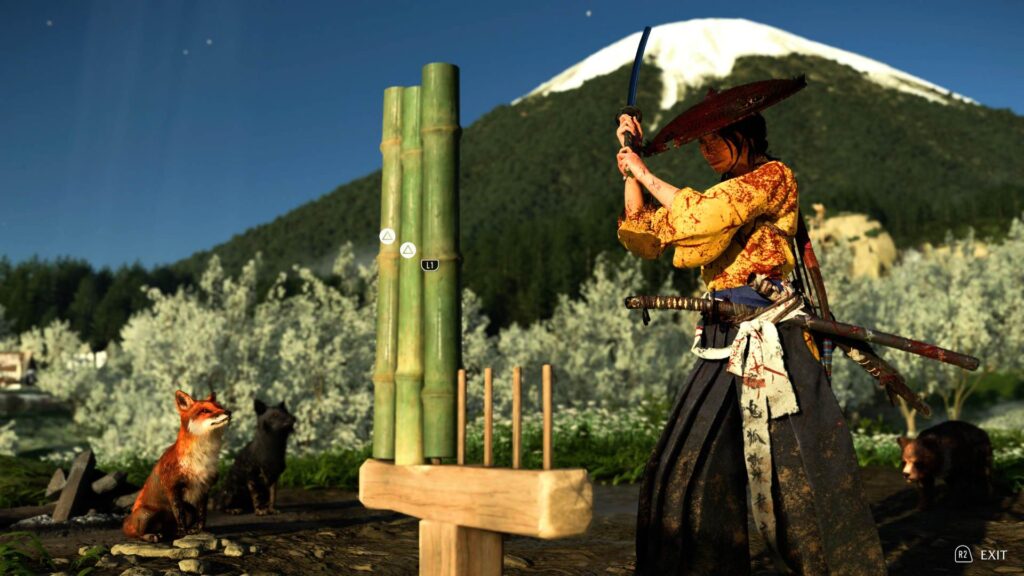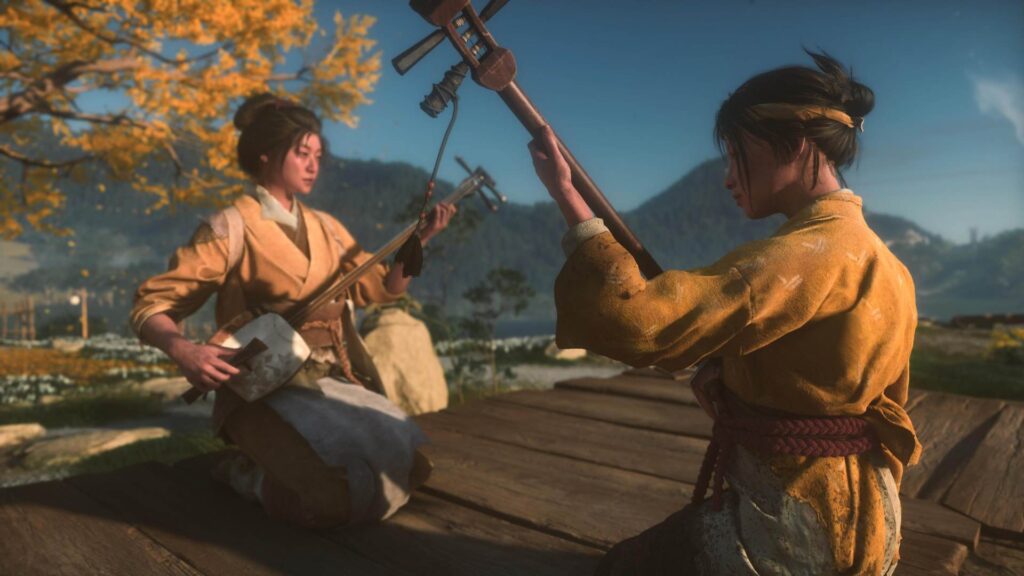After a long 5-year wait, Ghost of Yōtei has finally launched on PlayStation 5. Eagerly awaiting it myself, I thoroughly enjoyed Jin Sakai’s story in Ghost of Tsushima to the point of getting the Platinum trophy a while back. Now with Atsu as the protagonist, I was promptly reminded what I loved about these games as soon as I played it. The Ghost series pride itself in being a massive open-world just like the rest of them, but presented in such a breezy manner, pun intended, to the point of lightly guiding you by the wind via its minimalistic UI.
Instead of bombarding you with a minimap full of dots to diligently check off a list, Ghost of Yōtei eases you into its revenge story. With a clear goal to defeat the Yōtei Six, who have been tormenting the historical region of Ezo in 17th century Japan, you must gather information on where to find and execute them. The distinct feel Atsu’s journey has comes straight from how the side content is shown.
Because Ghost of Yotei does not hold your hand, instead of overloading you with laundry to-do lists, it lets you freely find your way around. This means that sometimes you could find yourself aimlessly galloping around with no real sense of purpose. While that can be liberating, it can be frustrating for goal-oriented players. As I found my bearings over the course of 15 hours of playtime, while not much has changed in the way the game works as a sequel, it definitely feels more sure of itself while doing it. This can be puzzling for newcomers, so here are my essential tips for Ghost of Yōtei.

Be Aware Of Your Surroundings
Once the riveting prologue ends, you are free to explore to your heart’s content. Considering how massive the game actually is, the sheer amount of activities can be a daunting proposition for some. To not overwhelm players with its many options, Ghost of Yōtei takes a more relaxed approach to how it throws tasks your way instead of laying them out directly. While taking in the vast fields all the way to Mount Yōtei, you will probably recognize the many signals of white smoke coming from settlers all over. Every place that you visit will undoubtedly have something waiting for you.
From Buddhist monks to entire buildings, the dense map layout serves as a way for players to explore in a more instinctive way without having a persistent dot throughout the whole game. Making guidance this austere helps provide the player with a sense of clarity without being overburdened with the abundant encounters they’ll clear in each play session. What also helps in being observant of your surroundings is the golden bird that may take you to undiscovered places. Because not every single area emanates a white smoke, sometimes aimlessly exploring new areas of the map can reward you with unexpected results.
Look Carefully For Clues
I know, this sounds like a given in a game of this type. But my mind kept going back to The Witcher 3 in which you can always fall back to your Witcher Senses where every interactable object is highlighted. Or Death Stranding and Horizon with your technological devices. Ghost of Yōtei’s side quests, just like the rest of the game, are very light on clues when you are inspecting an abandoned camp, for example. As nothing is highlighted and there is no button to do so, using your logic is always what will help you progress.

Looking at the campfire, notes on trees, the nearby river and so on will usually be enough to trigger the next cutscene. While the game thrives in being less handholdy than others of its kind, this can sometimes lead to not knowing exactly what to do. Horse tracks in the mud or climbing down a cliff will take you to the next step in the quest more often than not. Instantly progressing on to the next stage is what almost all players want to do at all times, but Yōtei’s laissez-faire approach helps with immersion in the long run, allowing players to have a more successfully engrossing adventure than other open world games of its kind.
Explore Cleared Camps For Loot
Just like most other open-world games of its type, Ghost of Yōtei has plenty of enemy camps that you can clear out any way you wish to do so. There is the usual standoff in which you slowly wait for the enemy to make their move to attack just right before them and fight the rest of them. The more subtle stealth approach in which with the help of tall grass, well-placed arrows and rooftops you silently eradicate enemy numbers one by one. And the more common of them all, try to sneak your way only to fail miserably, sloppily be caught and go in guns blazing as you mow down the unfortunate soldiers coming your way.
The most direct advice here would be to always take the chance to clear every enemy camp that you see, as they will usually reward you with useful items and skill points, but no. The reason I add that you should explore cleared camps for loot is for several reasons. First and foremost, once the cutscene ends when all enemies are defeated, Atsu will always be dropped right in front of a handful of items and chests. Heading out to the next quest is what most players will do, but after looting these hard-earned items, consider taking a walk around the camp. Perhaps while you were busy parrying and impaling foes, you missed a bottle of sake somewhere.

Do All Side Content
HEAR ME OUT. I know it is easy to dismiss this one because it is obvious that to see all Ghost of Yōtei has to offer, every nook and cranny must be explored. BUT. The reason I add this is due to the fact that Yōtei does not work as a common RPG in which you simply kill enemies and are given experience to level up. That couldn’t be further from the truth. Cleverly implementing a system that encourages exploration instead of grinding, the best way to improve your stats and abilities is by going off the beaten path.
All skills must be hard-earned by finding them in an Altar of Reflection, most of them hidden away, mostly unlocked by being guided by an NPC whilst doing their side quest. The rich skill trees, each benefitting with unique moves for combat or traversal, can only be accessed by praying at these shrines. Same goes for your wolf companion. The infamous hot springs where Jin used to go bare naked to reminisce and increase his health make their appearance here as well. Finally, new armor that affect your stats and fashionable dyes for outfits are tucked away at far off locations with special vendors awaiting to reward your curiosity.
Go To Yōtei’s Shadow Inn Often
Without going too much into detail, Yōtei’s Shadow Inn serves as a base of operations for Atsu to come back to once the place welcomes you with open arms. This comes in handy as there are plenty of merchants for you to barter with in one same place without having to hunt them down one by one. It also helps to see a place hustling and bustling, unlike the overall map which while it looks beautiful, it is sparsely populated.

A useful cartographer supplying less-than-reachable locations with special rewards tells you about his life story while hiding in this region of Japan. A blacksmith, tired of the war-ravaged mainland, is now a calm tea-drinker willing to help you out with any of your outfitting needs. Every onna-musha (female samurai) needs her arsenal deadly and ready, with a chatty bowyer in said inn offering her expertise in such matter. Last but not least, the bounty hunting board to hunt down ruthless ronin is refreshed every so often to never run out of things to do.
In short, there are plenty of upgrades for your weapons and armor that you will need to come back to every so often to pay with your hard-earned loot. A sporadic but fruitful conversation between Atsu and one of her interlopers is a welcome surprise, too.
Tinker With The Game’s Settings
This is a more personal advice that I would like more people to look into. What I love about PlayStation games in general is their extensive accessibility options that allow players to deeply customize the way they engage with the video game. The gimmick DualSense minigames that seem entertaining but are not up to your speed? Out the door with just a simple tweak on the accessibility menu. But more than that, there are ways to make it more comfortable for each player.
The difficulty settings, for instance, lets players go beyond the usual Easy-Normal-Hard options to actually change what they like the most in combat. Arguably the most fun element of the game, there are choices to ease or increase the enemy’s damage and aggressiveness, or how difficult it is to pull off a thrilling perfect parry. Because a set of wrong moves when assaulted by several enemies can result in an instant death, it is primordially more fun to change some settings to your liking in lieu of hitting a wall to the point of anger.

The camera shake, which is egregiously turned up to 100, should also be turned down to thoroughly appreciate the game’s gorgeous graphics to the fullest. With more modes than ever before, the Kurosawa, Miike and Watanabe effects add a tonally different flavor to the vanilla playthrough to increase replayability. I would recommend toggling those once the main story is done.
And there you have it. Ghost of Yōtei is a rich single-player experience that should be played any way you want to, but hopefully with these brief pointers you can more easily find your footing. Thanks for reading my Essential Guide, and enjoy Ezo!
Remember to follow us on Twitter, Facebook, and Bluesky to keep up to date on everything we have going on!